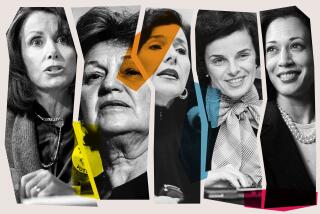The Public Woman as Honorary Man : THE WARRIOR QUEENS <i> by Antonia Fraser (Alfred A. Knopf:</i> $22.95; 383 pp.)
- Share via
“The Warrior Queens,” Antonia Fraser’s most recent historical essay, is lore-packed, quirky in its approach, and fascinating to read. If nonfiction books can be thought of as detailed answers to unvoiced questions, then the question answered by this one is: How have female political and military leaders gotten away with it? How have they managed to fob themselves off on those hardest to convince--soldiers and other politicians, those quintessentially male devisers and players of boys’ games--as worthy leaders of the charge or captains of the ship of state, although long of hair and bulgy of breast? Such women have been few enough in number so that the exceptions have very much proven the rule. But what about those exceptions? What was their strategy, their sleight-of-hand? What was their secret?
In pursuit of answers, Fraser has assembled a remarkable group of women for our contemplation. She begins with Boadicea herself, that famed but shadowy 1st-Century British tribal queen who led a revolt against the occupying and oppressive Romans, massacred a lot of them, and was said to have committed suicide when her forces were massacred in return. Fraser provides as faithful an account of the events as is possible, given that information is scarce and reports vary. But she is just as interested in Boadicea’s metamorphoses in historical and literary accounts through the ages--from pious patriot and martyr, mother of her people, to unwomanly, bloodthirsty shrew, to symbol of heroic British imperialism, ironic in view of the fact that her own revolt was against an earlier imperialism. The accounts of her have varied according to what men considered proper womanly behavior, and to what the British considered proper British behavior; thus Boadicea has been both slut and saint. Very early on, the myth detached itself from the real woman in question, and has been floating around ever since, ready to stick itself like a leech to any woman hardy enough to brandish a spear or declare for office.
Fraser follows up with a varied assortment of women from many centuries and civilizations who have held, however briefly, the reins of power: Zenobia, the 3rd-Century Queen of Palmyra who also challenged Roman rule; Empress Maud, of the 12th-Century English wars of succession; Queen Tamara of Georgia, “The Lion of the Caucasus”; Elizabeth I, inspiring her troops to battle the Spanish Armada; Isabella of Spain; the engaging Queen Jinga of Angola, who successfully defied the Portuguese colonists; Catherine the Great of Russia; the Vietnamese heroines, Trung Trac and Trung Nhi; the amazing Rani of Jhansi, who fought the British in India; Indira Gandhi, Golda Meir, and a good many more, concluding with that handy bookend to Boadicea, Margaret Thatcher. Their childhoods, their paths to leadership, and their styles vary enormously, but they have one thing in common: All were instantly mythologized. Male military leaders, taken for all in all, have been men, and that has been enough; but female ones cannot be mere women. They are aberrations, and as such are thought to partake of the supernatural or the monstrous: angels or devils, paragons of chastity or demons of lust, Whores of Babylon or Iron Maidens. Sometimes they have profited from the female saints or goddesses available to them through their cultures, sometimes they have had to work against such images. Their femininity has been both shackle and banner.
As leaders, they have had to be, like female doctors a decade ago, better than men. They have shamed their male followers by displaying superior courage; they have shamed their male adversaries by inflicting defeat on them at the hands of a mere woman. They have outmaneuvered, outtalked, outblustered, and in some cases outshot and outridden the cream of the male crop. Altogether they are an impressive lot, and Fraser is to be congratulated for rescuing them from their own myths and for giving them their due as individuals, the lesser-known among them as well as the household words.
But although they have been trotted out like a roll call by many advocates for the equality of women, and presented in many guises--from turn-of-the-century pageants to Judy Chicago’s “Dinner Party”--these women have seldom allied themselves with women in general, or with movements for the improvement of their lot. More typically, they have distanced themselves from women, like Elizabeth I, who was against female rule but saw herself as a divinely placed exception, or like Catherine the Great, who spoke of the “weak, frivolous, whining species of women.” Many have preferred the status of honorary males. If you’re playing boys’ games, you need to be one of the boys.
This book should be required reading for any woman going into politics, truck-driving or the Army; indeed, by any woman going into anything, unless her chosen field is uniquely feminine. Public women are put through different tests of nerve, attract different kinds of criticism, and are subject to different sorts of mythologizing than are men, and “The Warrior Queens’ ” indicates what kinds.
Those of us for whom politics is a spectator sport will find it useful, too. It goes a long way toward explaining the various media transformations of, for instance, Margaret Thatcher, from her Attila-the-Hen period through her Iron-Maiden-Falkland-War phase to her incarnation as an editorial-cartoon Boadicea, complete with whip and chariot, triumphant on election day and dragging a clutch of pygmy men in her wake. Women leaders, it seems, find it difficult to be life-sized. For good or ill, they are gigantic.
More to Read
Sign up for our Book Club newsletter
Get the latest news, events and more from the Los Angeles Times Book Club, and help us get L.A. reading and talking.
You may occasionally receive promotional content from the Los Angeles Times.






